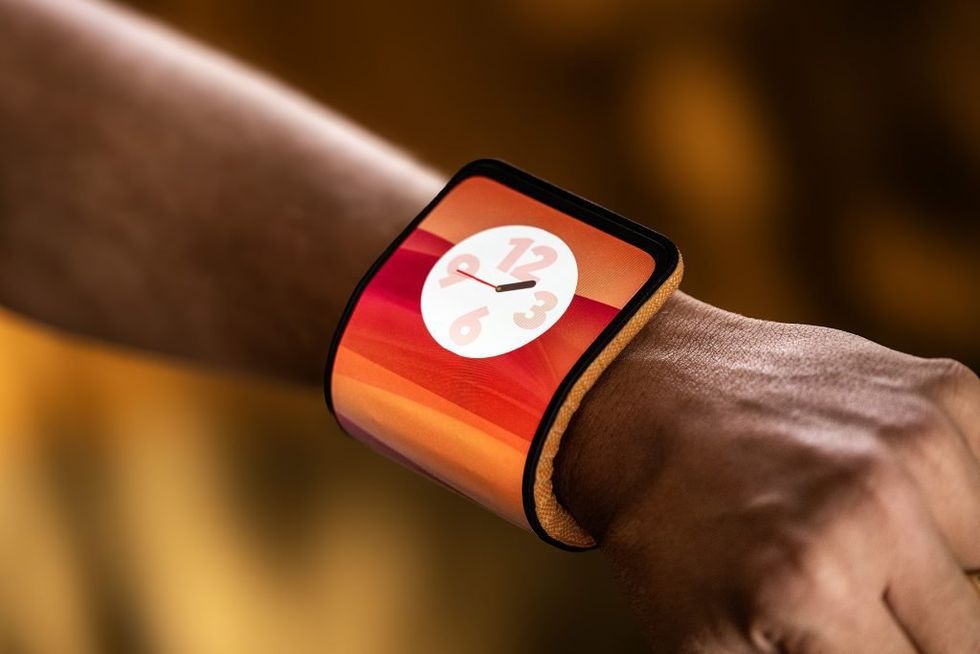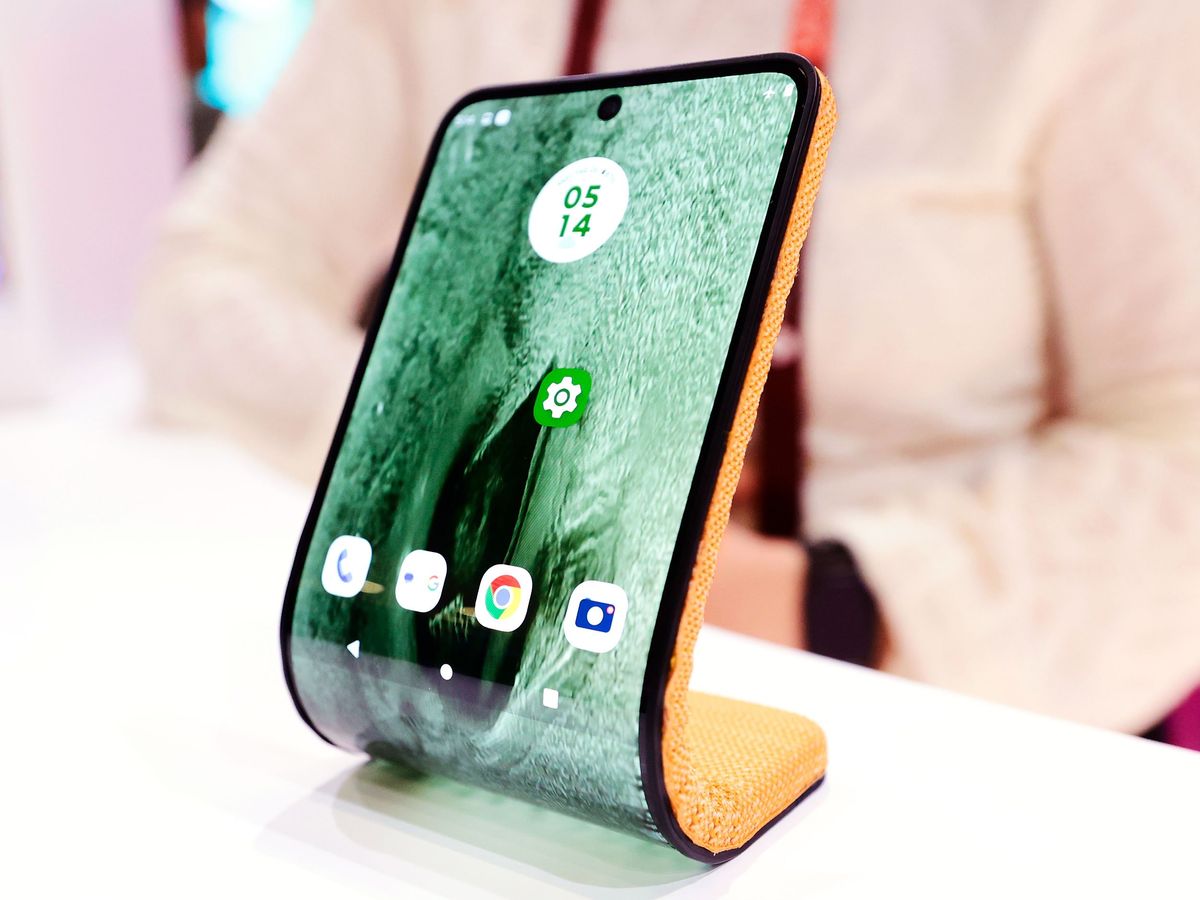The Mobile World Congress (MWC), a technology convention held each year in Barcelona, placed a spotlight on rollable phones like the Phantom Ultimate, a scroll-like concept from Tecno Mobile, and Motorola’s Adaptive Display Concept, a phone that can wrap around your wrist like a smartwatch. They were followed by a new patent filed by Samsung that hints at a future smartphone or tablet that rolls up like a newspaper.
Flexible OLED isn’t a new technology. It’s found not just in folding smartphones but also laptops, computer monitors, televisions, and other consumer technology. These applications stretch, curve, and fold displays into various configurations, leaving rollable OLED as the last hurdle to leap.
“A lot of people are excited. [Rollable OLED] looks very futuristic. But for any company to start making a move and coming up with a commercial device, they want to get it right the first time and find what’s most compelling,” says Eric Virey, a Portland, Ore.–based senior market and technology analyst for Yole Group.
Rollable-Display Mechanical Challenges
The Royole FlexPai, released in 2018, was the first smartphone with a foldable OLED display. It wasn’t well-received, however, and Samsung’s popular Galaxy Fold stole the spotlight. Today, foldable OLED displays are found in dozens of consumer smartphones and PCs including the Huawei Mate X3 and Lenovo ThinkPad X1 Fold.
Rollable OLED displays are closely linked to foldable OLED displays. The panel technology used by each is the same and the mechanical design is similar. Yet rollable displays have proven difficult to produce.
The LG Signature Rollable OLED TV R, released in 2021, was the only consumer device to ever ship with a rollable OLED display. It was priced at US $100,000. Virey says it likely sold poorly, and LG has since discontinued the television. According to a report from Korea JoongAng Daily, LG sold only 10 rollable OLED TVs in Korea within its first few months of availability, a turn of fortune that prompted LG to reel back its rollable ambitions.

Jacky Qiu, cofounder and vice president at Ontario, Canada–based OLED materials company OTI Lumionics, says the mechanical realities of a rollable design are challenging. A rollable smartphone demands a more flexible display that can roll into a tighter curvature than today’s foldable phones.
“These are mechanical issues,” says Qiu. “If you have a piece of cardboard, it’s very hard to fold, and even harder to roll. If you have a sheet of photocopy paper, it’s much easier.”
Reducing the thickness of a rollable design is key, but easier said than done. That’s true for both the OLED display itself and a smartphone’s other components. A phone requires a system-on-a-chip, memory, storage, a camera, battery, and other electronics—and while some breakthroughs have occurred in flexible chips and bendy memory, the technology isn’t ready for consumer devices.
Lessons From Foldable Displays
Yet that doesn’t mean rollable OLED is hopeless.
Foldable OLED devices, which faced similar problems, provided OLED display makers and smartphone manufacturers an opportunity to learn lessons that also apply to rollables. Early foldable smartphones had problems with reliability and display glare that stemmed from the difficult task of designing a durable yet flexible display. More modern designs benefit from overlooked but crucial advancements, such as improved polarizers.
A display polarizer “traditionally is three or four layers of optical films that are themselves thick and will hinder your fold,” says Qiu. “That has to be replaced.” He points to Samsung’s POL-LESS OLED technology, used for the company’s Eco 2 OLED display on recent Galaxy Z Fold smartphones, as an example of the incremental innovation required to improve flexible OLED displays. Qiu says modern flexible OLED displays also benefit from better encapsulation, which protects the OLED material inside the display from outside contaminants.
Virey and Qiu agree that flexible OLED displays don’t require a technology breakthrough to make rollable possible, and the rollable prototypes shown at MWC 2024 proved that point. They used a variety of strategies to accommodate portions of a smartphone that can’t be made flexible. Some let users roll out a display from an otherwise conventional phone to extend the display, while others allow the display to flex through the middle and place components at each end.
The Tecno Phantom Ultimate is a concept phone with an OLED display that rolls out like a scroll.Tecno
Now, the real question is this: Which smartphone maker will be first to take the plunge?
“It’s the chicken and the egg,” says Qiu. “If Oprah says, ‘This is the best thing since sliced bread,’ a bunch of people will throw money at it and it becomes very cheap. But until that point, you need to generate demand to get the cost down.”
That’s why patents filed by large device manufacturers, like Samsung, lead to renewed buzz around rollable concepts. Samsung was responsible for popularizing flexible OLED displays with the Galaxy Fold and, for a time, it had the concept all to itself. But there are now dozens of folding OLED smartphones and computers available, and foldable devices are beginning to feel mundane. That could push Samsung—or, possibly, another smartphone manufacturer eager to steal Samsung’s thunder—to put rollable OLED in your pocket.
“I think it could come up quick,” says Virey. “When I first saw rollable devices a few years back, they were always behind the window. They wouldn’t let you play with it, because they knew you’d break it right away. [At this year’s MWC], I saw a lot of journalists were playing with it. [Device makers are] more confident it’s robust enough to at least survive a trade show. So, if you want a wild guess, I would say within two years we might get the first gadget.”
Matthew S. Smith is a freelance consumer technology journalist with 17 years of experience and the former Lead Reviews Editor at Digital Trends. An IEEE Spectrum Contributing Editor, he covers consumer tech with a focus on display innovations, artificial intelligence, and augmented reality. A vintage computing enthusiast, Matthew covers retro computers and computer games on his YouTube channel, Computer Gaming Yesterday.



